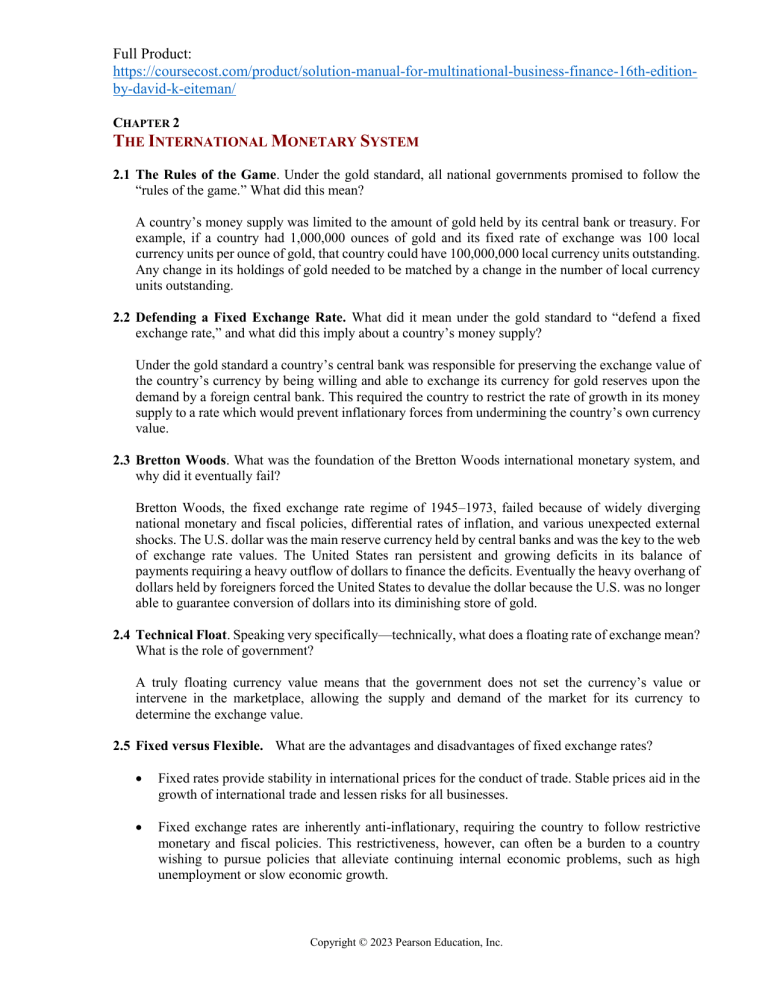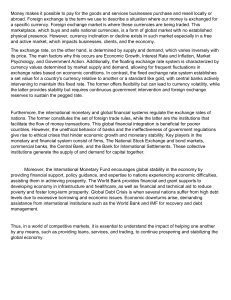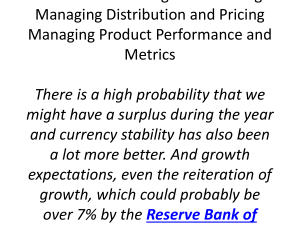
Full Product:
https://coursecost.com/product/solution-manual-for-multinational-business-finance-16th-editionby-david-k-eiteman/
CHAPTER 2
THE INTERNATIONAL MONETARY SYSTEM
2.1 The Rules of the Game. Under the gold standard, all national governments promised to follow the
“rules of the game.” What did this mean?
A country’s money supply was limited to the amount of gold held by its central bank or treasury. For
example, if a country had 1,000,000 ounces of gold and its fixed rate of exchange was 100 local
currency units per ounce of gold, that country could have 100,000,000 local currency units outstanding.
Any change in its holdings of gold needed to be matched by a change in the number of local currency
units outstanding.
2.2 Defending a Fixed Exchange Rate. What did it mean under the gold standard to “defend a fixed
exchange rate,” and what did this imply about a country’s money supply?
Under the gold standard a country’s central bank was responsible for preserving the exchange value of
the country’s currency by being willing and able to exchange its currency for gold reserves upon the
demand by a foreign central bank. This required the country to restrict the rate of growth in its money
supply to a rate which would prevent inflationary forces from undermining the country’s own currency
value.
2.3 Bretton Woods. What was the foundation of the Bretton Woods international monetary system, and
why did it eventually fail?
Bretton Woods, the fixed exchange rate regime of 1945–1973, failed because of widely diverging
national monetary and fiscal policies, differential rates of inflation, and various unexpected external
shocks. The U.S. dollar was the main reserve currency held by central banks and was the key to the web
of exchange rate values. The United States ran persistent and growing deficits in its balance of
payments requiring a heavy outflow of dollars to finance the deficits. Eventually the heavy overhang of
dollars held by foreigners forced the United States to devalue the dollar because the U.S. was no longer
able to guarantee conversion of dollars into its diminishing store of gold.
2.4 Technical Float. Speaking very specifically—technically, what does a floating rate of exchange mean?
What is the role of government?
A truly floating currency value means that the government does not set the currency’s value or
intervene in the marketplace, allowing the supply and demand of the market for its currency to
determine the exchange value.
2.5 Fixed versus Flexible. What are the advantages and disadvantages of fixed exchange rates?
Fixed rates provide stability in international prices for the conduct of trade. Stable prices aid in the
growth of international trade and lessen risks for all businesses.
Fixed exchange rates are inherently anti-inflationary, requiring the country to follow restrictive
monetary and fiscal policies. This restrictiveness, however, can often be a burden to a country
wishing to pursue policies that alleviate continuing internal economic problems, such as high
unemployment or slow economic growth.
Copyright © 2023 Pearson Education, Inc.
8
Eiteman/Stonehill/Moffett Multinational Business Finance, Sixteenth Edition
Fixed exchange rate regimes necessitate that central banks maintain large quantities of
international reserves (hard currencies and gold) for use in the occasional defense of the fixed rate.
As international currency markets have grown rapidly in size and volume, increasing reserve
holdings has become a significant burden to many nations.
Fixed rates, once in place, may be maintained at rates that are inconsistent with economic
fundamentals. As the structure of a nation’s economy changes, and as its trade relationships and
balances evolve, the exchange rate itself should change. Flexible exchange rates allow this to
happen gradually and efficiently, but fixed rates must be changed administratively—usually too
late, too highly publicized, and at too large a one-time cost to the nation’s economic health.
2.6 De Facto and de Jure. What do the terms de facto and de jure mean in reference to the International
Monetary Fund’s use of the terms?
A country’s actual exchange rate practices is the de facto system. This may or may not be what the
“official” or publicly and officially system commitment, the de jure system.
2.7 Crawling Peg. How does a crawling peg fundamentally differ from a pegged exchange rate?
In a crawling peg system, the government will make occasional small adjustments in its fixed rate of
exchange in response to changes in a variety of quantitative indicators such as inflation rates or
economic growth. In a truly pegged exchange rate regime no such changes or adjustments are made to
the official fixed rate of exchange.
2.8 Global Eclectic. What does it mean to say the international monetary system today is a global
eclectic?
The current global market in currency is dominated by two major currencies, the U.S. dollar and the
European euro, and after that, a multitude of systems, arrangements, currency areas, and zones.
2.9 The Impossible Trinity. Explain what is meant by the term impossible trinity and why it is in fact
“impossible.”
The impossible trinity is the principle that a country cannot simultaneously maintain a fixed exchange
rate, conduct independent monetary policy, and allow free movement of capital in and out of the
country.
Countries with floating rate regimes can maintain monetary independence and financial
integration but must sacrifice exchange rate stability.
Countries with tight control over capital inflows and outflows can retain their monetary
independence and stable exchange rate, but surrender being integrated with the world’s capital
markets.
Countries that maintain exchange rate stability by having fixed rates give up the ability to have
an independent monetary policy.
2.10 The Euro. Why are the formation and use of the euro considered to be of such a great accomplishment?
Was the euro really needed? Has it been successful?
The creation of the euro required a near-Herculean effort to merge the monetary institutions of separate
sovereign states. This required highly disparate cultures and countries to agree to combine, giving up a
Copyright © 2023 Pearson Education, Inc.
Chapter 2: International Monetary System
9
large part of what defines an independent state. Member states were so highly integrated in terms of
trade and commerce, maintaining separate currencies and monetary policies was an increasing burden
on both business and consumers, adding cost and complexity which added sizeable burdens to global
competitiveness. The euro is widely considered to have been relatively successful since its launch,
although in recent years there has been increasing frustration from several member countries over their
lack of discretionary monetary policy and exchange rate value.
2.11 Currency Board or Dollarization. Fixed exchange rate regimes are sometimes implemented through
a currency board (Hong Kong) or dollarization (Ecuador). What is the difference between the two
approaches?
In a currency board arrangement, the country issues its own currency, but that currency is backed 100%
by foreign exchange holdings of a hard foreign currency—usually the U.S. dollar. In dollarization, the
country abolishes its own currency and uses a foreign currency, such as the U.S. dollar, for all domestic
transactions.
2.12 Argentine Currency Board. How did the Argentine currency board function from 1991 to January
2002, and why did it collapse?
Argentina’s currency board exchange regime of fixing the value of its peso on a one-to-one basis with
the U.S. dollar ended for several reasons:
As the U.S. dollar strengthened against other major world currencies, including the euro, during the
1990s, Argentine export prices rose vis-à-vis the currencies of its major trading partners.
This problem was aggravated by the devaluation of the Brazilian real in the late 1990s.
These two problems, in turn, led to continued trade deficits and a loss of foreign exchange reserves
by the Argentine central bank.
This problem, in turn, led Argentine residents to flee from the peso and into the dollar, further
worsening Argentina’s ability to maintain its one-to-one peg.
2.13 Special Drawing Rights. What are Special Drawing Rights?
The Special Drawing Right (SDR) is an international reserve asset created by the IMF to supplement
existing foreign exchange reserves. It serves as a unit of account for the IMF and other international and
regional organizations and is also the base against which some countries peg the exchange rate for their
currencies.
Defined initially in terms of a fixed quantity of gold, the SDR has been redefined several times. It is
currently the weighted value of currencies of the five IMF members having the largest exports of goods
and services. Individual countries hold SDRs in the form of deposits in the IMF. These holdings are part
of each country’s international monetary reserves, along with official holdings of gold, foreign
exchange, and its reserve position at the IMF. Members may settle transactions among themselves by
transferring SDRs.
2.14 The Ideal Currency. What are the attributes of the ideal currency?
Copyright © 2023 Pearson Education, Inc.
10
Eiteman/Stonehill/Moffett Multinational Business Finance, Sixteenth Edition
If the ideal currency existed in today's world, it would possess three attributes, often referred to as The
Impossible Trinity:
1. Exchange rate stability. The value of the currency would be fixed in relationship to other major
currencies so traders and investors could be relatively certain of the foreign exchange value of each
currency in the present and into the near future.
2. Full financial integration. Complete freedom of monetary flows would be allowed, so traders and
investors could willingly and easily move funds from one country and currency to another in
response to perceived economic opportunities or risks.
3. Monetary independence. Domestic monetary and interest rate policies would be set by each
individual country to pursue desired national economic policies, especially as they might relate to
limiting inflation, combating recessions, and fostering prosperity and full employment.
The reason that it is termed The Impossible Trinity is that a country must give up one of the three
goals described by the sides of the triangle: monetary independence, exchange rate stability, or full
financial integration. The forces of economics do not allow the simultaneous achievement of all three.
2.15 Emerging Market Regimes. High capital mobility is forcing emerging market nations to choose
between free-floating regimes and currency board or dollarization regimes. What are the main
outcomes of each of these regimes from the perspective of emerging market nations?
Highly restrictive regimes like currency boards and dollarization require a country to give up the
majority of its discretionary ability over its own currency’s value. Currency boards, like that used by
Argentina in the 1990s, restricted the rate of growth in the country’s monetary policy in order to
preserve a fixed exchange rate regime. This proved to be a very high price for Argentine society to pay,
and in the end could not be maintained. Dollarization, an even more radical extreme in the adoption of
another country’s currency for all exchange, removes one of a government’s major attributes of
sovereignty.
In a free-floating regime the government allows the foreign currency markets to determine the
currency’s value, although the government does maintain sovereignty over its own monetary policy
which in turn has significant direct impacts on the currency’s value.
2.16 Globalizing the Yuan. What are the major changes and developments that must occur for the Chinese
yuan to be considered “globalized”?
First, the yuan must become readily accessible for trade transaction purposes. This is the fundamental
and historical use of currency. Secondly, it then needs to mature toward a currency easily and openly
useable for international investment purposes. The third and final stage of currency globalization is
when the currency itself takes on a role as a reserve currency, currency held by central banks of other
countries as a store of value and a medium of exchange for their own currencies.
2.17 Triffin Dilemma. What is the Triffin Dilemma? How does it apply to the development of the Chinese
yuan as a true global currency?
The Triffin Dilemma is the potential conflict in objectives that may arise between domestic monetary
and currency policy objectives and external or international policy objectives when a country’s
currency is used as a reserve currency. Domestic monetary and economic policies may on occasion
require both contraction and the creation of a current account surplus (balance on trade surplus).
Copyright © 2023 Pearson Education, Inc.
Chapter 2: International Monetary System
11
2.18 China and the Impossible Trinity. What choices do you believe that China will make in terms of the
impossible trinity as it continues to develop global trading and use of the Chinese yuan?
This is purely speculative opinion, but many believe China will continue to move the yuan toward
globalization rapidly. As Chinese financial institutions and policies become more mature, and policies
more consistent with those of other major country financial markets, the yuan will grow as a medium of
exchange for both commercial trade and capital investment transactions. The gradual opening of the
Chinese economy to foreign investment is a critical component of this process.
2.19 Reserve Currencies. What do reserve currencies tell us about what the world’s central banks think of
what currencies will retain value over time?
The U.S. dollar continues to play the role of the world’s dominant reserve currency, followed by the
euro. This dominance reflects a widely held belief across nations that the U.S. economy, fundamental to
the dollar’s value, will remain relatively healthy over time. In many ways a currency’s value reflects the
health of the sponsoring nation’s economy. The single largest threat to that health or value—in the eyes
of central banks—is inflation. The recent resurgence of inflationary forces in the United States and
Europe will be followed very closely by the markets and the bankers.
A reserve currency, however, must also be seen as widely “acceptable” across markets, nations, and
central banks. This acceptability for the dollar has been extended through an increasing number of
cooperative agreements between central banks, agreements that allow a nation to access additional
reserve resources (e.g., reserve swap agreements) when needs arise.
2.20 Digital Currencies. What will be the likely impacts on the international monetary system of the
introduction of digital currencies like the digital yuan? Will they replace physical currency—paper
money? Or will they be relegated to the electronic payment systems in their home countries with
limited cooperation across borders?
Digital currencies have the potential to disrupt much of the international monetary system. They may
largely replace physical currency (paper money) first, followed by a restructuring of the relationship
between commercial banks (which have their risks including credit risk) and central banks (that cannot
fail). Although academics and various organizations have advocated the principle of coexistence
between CBDCs and commercial digital payment systems, it remains to be seen if that will play out in
reality. A central bank digital currency could be seen as a direct competitor, a superior competitor, to
private sector payments systems and digital wallets.
Will digital currencies remain captive within national borders? Not likely. Despite differing laws and
regulations for financial transactions across borders, the power, strength, and ease of a major
developing digital currency like the eYuan could result in a very powerful force. Many countries that
have long struggled to manage their domestic currencies may soon find they can “outsource” their
currency to a new, strong, digital currency of a major economic power like that of China. The coming
years may see some extraordinary developments in the growth and expansion of digital currencies, the
eYuan first and foremost.
Copyright © 2023 Pearson Education, Inc.






